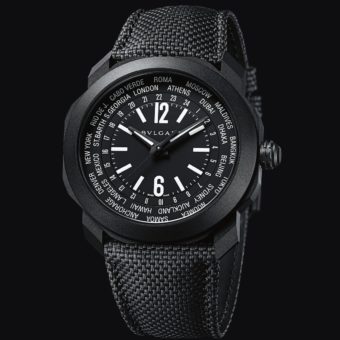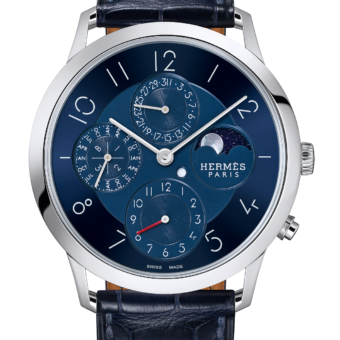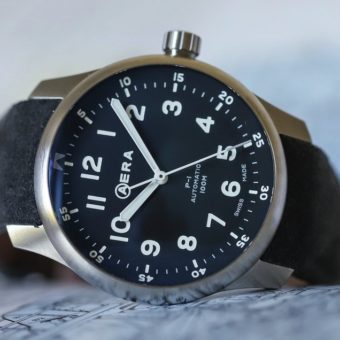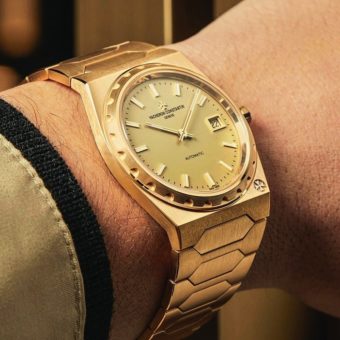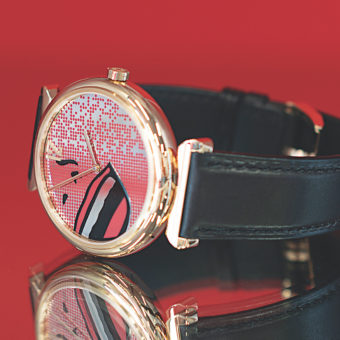
In many ways, the story of Christophe Claret is the story of the Swiss watch industry. He is independent and innovative. Much of his work is done in secrecy. He designed and created many of the most complicated movements introduced during the past 20 years. Now, Claret emerges from behind the curtain to produce timepieces under his own name.
We caught up with Christophe Claret during a recent visit to his West Coast agent, Lussori. We had a chance to admire his latest masterpiece, and to explore his impressive horological achievements (at least those he is free to disclose). We also discussed the next chapter in his story.

Only a small handful of brands have the ability to design highly complicated movements, then manufacture the required components in-house. Fewer still design the machines that make the components. Claret does both, and more, placing him at the pinnacle of the manufacture hierarchy.
Claret seems to have been born to be a watchmaker. He grew up in Lyon, France, and even as a child, he enjoyed disassembling and reassembling watch movements. At 16, he entered the watchmaking school in Geneva, and following graduation, he restored antique timepieces. His career was launched at the 1987 Basel Fair, when the owner of a major Swiss watch company asked Claret to develop an exclusive minute repeater movement. On the strength of that commission, Claret founded a company with two other talented watchmakers. In 1992, he bought his partners out and became the sole shareholder. The company name was changed to Christophe Claret S.A.
In 2000, to cement his independence, Claret purchased an early-20th century manor house in Le Locle known as Le Soleil d’Or (The Golden Sun), originally built by Urban Jürgensen. Since the acquisition, Claret has added two modern wings that today house one of the world’s most advanced facilities for designing and creating complicated movements, as well as cases, sapphire crystals, and other components.
The entrance to Christophe Claret S.A. A visual industry metaphor, the old manor house stands in front of the modern manufacturing wings.

In 2005, Claret’s company had 35 employees. The luxury watch boom, and the desire by many brands to offer more and more complicated timepieces, drove Claret’s growth. Today the company has about 90 employees. Claret remains the sole shareholder, and in another show of independence, he does not rely on any bank, instead funding operations entirely from cash flow.
Since its founding, Claret’s company has created about 64 different movements, including more than 50 world firsts, a claim that cannot be made by many much older brands. For perspective on this achievement, consider that A. Lange & Söhne, a respected and prolific manufacture, has created about 35 new movements since its rebirth in 1994. Claret’s facility with complexity also dwarfs large brands: at Claret, a tourbillion is the simplest watch they make.
The movement from Jean Dunand’s Shabaka

For the most part, Claret is unable to reveal the true scope of his accomplishments, due to confidentiality agreements with brands whose movements he designs and builds. A partial list of his accomplishments includes the following:
– The Opus 4 and Tourbillon Glissière for Harry Winston
– The Maîtres du Temps Chapter One
– Jean Dunand’s Palace, Tourbillon Orbital, and Shabaka with minute repeater with cathedral gong-rings, complete perpetual calendar with an instant-change function and a unique and original display, moon phases and leap-year indication, and an ingenious winding indicator.
– A The bi-tourbillon and bi-minute repeater with retrograde GMT, large date and shooting star mechanism for deLaCour
– The Jorg Hysek Colosso GMT minute repeater.
Claret has also done work for Ulysse Nardin, Bulgari (Daniel Roth & Gérald Genta), Guy Ellia, and Ellicott. This is but the tip of the proverbial iceberg.
A few of Claret’s many creations for other brands: top, Harry Winston Opus 4 and Jean Dunand Tourbillon Orbital. Below, Jorg Hysek Colosso GMT minute repeater and Maîtres du Temps Chapter One round


Today, Christophe Claret simultaneously works on about 40 different movements for 16 clients. Claret creates about five new movements each year, though last year saw eight. Claret currently produces about 400 movements per year, each assembled from start to finish by a single watchmaker.
The fine art of angling, and a Christophe Claret watchmaker.


Inside the industry, Claret is as well known for designing the complex machines used to make components as he is for his finished movements. Some Claret machines work to tolerances of one micron. An impressive list of clients stands as a testament to Claret’s skills in this area. Companies using his machines include Rolex, Patek Philippe, Breguet, Audemars Piguet, Vacheron Constantin, Greubel Forsey, Paul Gerber, Thomas Prescher , and Frédérique Constant. The machines sometimes generate as much secrecy as the movements they help to create: some areas of Claret’s manufacture are protected by fingerprint scanners to ensure only authorized employees gain admission.
A machine fashions a bridge from sapphire.

Until last year, Claret produced only movements to order. Beginning in 2009 with the DualTow, Claret is putting his immense talent and resources to work to create timepieces under his own name. For example, the complex, 114-piece curved DualTow case with articulating lugs is machined entirely in-house.
Claret’s cutting workshop, and the DualTow.



Looking forward, WatchTime can reveal that two new pieces bearing Claret’s name will be introduced in 2011. Unlike the DualTow, they will have round cases. The first piece will have a very classical style, and it will be launched during Claret’s exhibition in Geneva in January 2011.
The second piece, which will be launched at Baselworld 2011, is extremely innovative, but the complications differ from the DualTow, and the cost will be less than the DualTow’s SFr. 490,000 opening price.
Related Articles:
Christophe Claret’s Amazing DualTow
Christophe Claret DualTow NightEagle – Stealth That Gets Noticed
Palace Coup: Jean Dunand’s Newest Watch is a Tribute to the Industrial Revolution

